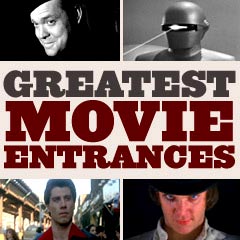
|
Entrances of All-Time 1970-1975 |
![]()
| Movie Title/Year and Film Character with Scene Description | ||

|
The AristoCats (1970)
Disney's animated feature film told about a Parisian diva who resided with a family of aristocratic cats in the early 20th century (year 1910). Retired opera singer Madame Adelaide Bonfamille (Hermione Baddeley) lived in her villa with Edgar Balthazar (Roddy Maude-Roxby), her English butler. The 'aristocats' she owned were:
When the Madame prepared her will with a lawyer, she named her cats as beneficiaries of her fortune following her death. But when the butler overheard her plans, he plotted to kill the cats, in order to cheat them and receive the inheritance. Edgar abandoned the cats (after drugging them) in the countryside, leaving them under a stone bridge. In the morning, an independent-minded, carefree ginger-colored, feral alley-tomcat named Thomas O'Malley sauntered into view next to the riverbank, singing his own theme song: "Thomas O'Malley."
His introductory appearance aroused the attention of Duchess, who was impressed by his long name which she said "seems to cover all of Europe." Soon after, Thomas offered to help Duchess and her kittens to return to Paris and oust Edgar. |
   
|
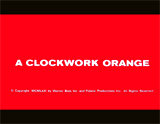
|
The opening memorable image was an intimate closeup (known as the Kubrick stare) of the blue staring eyes and smirking face of ebullient young punker Alex de Large (Malcolm McDowell), wearing a bowler hat and with one false eyelash (upper and lower) adorning his right eye. As the camera zoom pulled back slowly, accompanied by Walter Carlos' synthesized rendition of Purcell's Elegy on the Death of Queen Mary, the anti-hero character with the malevolent, menacing cold stare was shown sitting amidst his kingly court of teenaged gang of "droogs." He slowly drank milk and stared blankly forward. As the full view of the milk bar emerged, the droogs were seen surrounded by unusual, plastic naked female mannequins that served as tables. Alex narrated in voice-over:
|
    
Reverse Tracking Shot of Anarchic Leader of Gang of "Droogs" - Alex (Malcolm McDowell) |
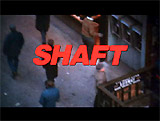
|
Shaft (1971)
The opening credits sequence in Gordon Parks' definitive blaxploitation film began with an aerial shot of NYC skyscrapers, when the camera sharply dipped down into the metropolitan streets below, and in a tracking shot located four tawdry 42nd Street theatre marquees. Suddenly, the title "SHAFT" zoomed out from the center of the frame, the theme song began to pound, and the camera focused on the appearance of sexy and cool black private detective John Shaft (Richard Roundtree) in a dark brown midi-coat, who was emerging from an underground subway onto the street. He was first seen from an overhead view, then from an impressive lower angled close-up of his face, before he crossed the street and proceeded down a sidewalk. The stirring Isaac Hayes Oscar-winning introductory theme song provided provocative lyrics:
|
 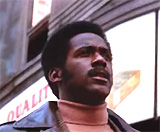 |

|
Willy Wonka & the Chocolate Factory (1971)
Legendary chocolate maker Willy Wonka (Gene Wilder) made his entrance when he exited his gated factory, limping and heavily relying on his cane, as if he were a decrepit old man. As he approached the outer gate walking on a ceremonial red carpet, he stopped unsteadily, teetered and then suddenly collapsed, eliciting a gasp from the gathered crowd. The admirers appeared to be disappointed by the appearance of the frail, elderly gentleman - was this really Willy Wonka? But then he performed a neat, perfectly-executed somersault with a spry flair and jumped up onto his feet - eliciting the crowd's applause and cheers. He was foreshadowing his own mischievous, cunning, enigmatic and secretive nature. He greeted everyone: "Welcome my friends. Welcome to my chocolate factory." |
   
|
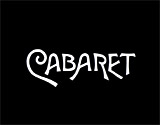
|
The film opened on a twisted, mirrored surface as a drum-roll began. When the cymbals crashed, the Emcee (Joel Grey) popped into the frame from below -- a deathly-pale, pasty-white angular face, with ruby-red lipsticked lips, and a demonic, dangerously-mischievous grin formed on his face. He greeted the patrons of the Kit Kat Club (and the movie audience) with the song Willkommen - in German, English and French: "Willkommen! Bienvenue! Welcome!" The Emcee introduced himself as the host, and told them that while life was dreary and troublesome, there were no problems in the Cabaret as he revealed the all-girl band:
He then introduced the audience to the Cabaret Girls by name (one of whom was a man in drag), cracking a dirty joke:
He then warned that every hot night, they had to battle to keep the Girls from taking all of their clothes off, before gleefully confiding:
|
  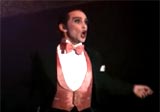
|
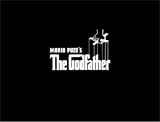
|
In Francis Ford Coppola's crime saga, set in late August, 1945, the opening scene began with a very slow camera pull-back from the face of a man who was in "Don" Vito Corleone's (Marlon Brando) dark home office. There, the the father of the bride, regally and ruthlessly holding court, was involved granting favors and promises to all petitioners and supplicants who paid homage. He was conducting the crime family business during his daughter's wedding reception, that was being held in the bright, sunshiny outdoor veranda of his Long Island compound. Seated in front of the Don's desk was an undertaker named Amerigo Bonasera (Salvatore Corsitto), speaking in a heavy accent. He delivered a lengthy speech, beginning with "I believe in America...." Bonasera was desperately pleading for a favor - proper vengeful "justice" (rather than American justice) or retribution for the threatened near-rape and brutal beating suffered by his daughter (whom he raised "in the American fashion") by her non-Italian boyfriend and his friend. After Bonasera's speech, Corleone was finally revealed listening to Bonasera's entreaties. The gentle, slow-moving and restrained Corleone sat behind his study's desk. His face had a bulldog appearance with padded cheeks, and he spoke with a high-pitched, hoarse, raspy, gutteral mumbling accent. On his lap was a cat whose head he lovingly and gently stroked. Although he moved stiffly, he wielded enormous lethal power as he determined the dispensation of real justice - who would be punished and who would be favored. He was upset that the funeral director Bonasera lacked respect, hadn't asked for a favor earlier or exhibited friendship, although he now asked for murderous revenge, and that Bonasera didn't call him "godfather."
|
  
|
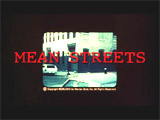
|
Director Martin Scorsese's early crime melodrama (his third feature film) opened with the memorable, sub-titled introduction of one of the film's main characters. The short scene introduced John "Johnny Boy" Civello (Robert De Niro), the reckless, violent, irresponsible young friend of up-and-coming, wannabe Charlie Cappa (Harvey Keitel), a religious-conflicted Italian-American Mafia member. Johnny Boy was an unbalanced, ne'er-do-well who was in debt to loan sharks, and lived a life of desperation, who often was provided protection by Charlie. Johnny Boy's introduction demonstrated how he was a loose cannon, out-of-control, and too wild to tame. The crazed, small-time hood was seen planting a homemade bomb in a USPS mailbox. Johnny himself was a ticking time bomb ready to explode. As he scurried away from the scene, the blast blew his porkpie hat from his head. The punk grabbed it and continued running, with a crazy grin on his face. He would go on to pick bar fights by swinging pool sticks on a pool table, and ultimately cause the downfall of his friend Charlie. |
   
|
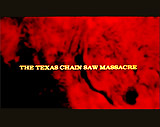
|
The Texas Chain Saw Massacre (1974)
In Tobe Hooper's classic slasher film set in Travis County, Texas, a group of five teens were searching for their grandfather's grave, in a cemetery desecrated (with at least a dozen empty crypts) by unknown assailants, although an investigation was underway. At a farm house near a slaughterhouse, there was the first and sudden appearance of chainsaw-wielding redneck killer Leatherface (Gunnar Hansen) in his "House of Horror" - inhabited by his family of cannibalistic psychopaths. It was justifiably one of the scariest, most memorable appearances in film history. When Kirk (William Vail) entered the unlocked front door of a deserted-looking clapboard house, he repeatedly called out: "Hello, hello...Anybody home?" He heard squealing noises and saw a open doorway in the hall beyond which was a red-colored wall covered with skulls and bones. There, he was immediately and surprisingly attacked by a lunging, apron-wearing, skin-masked Leatherface who clobbered him in the head with a large mallet or sledgehammer. He was knocked to the floor, where his legs extended outside the door. His legs kicked and twitched during a wild convulsive seizure as he was dragged into the killer's lair - and its steel-metal door was forcibly slammed shut by the brutal killer. |
    
|
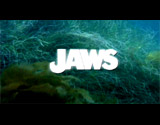
|
The film's most memorable entrance scene, besides the first appearance of the shark, occurred in a meeting among the town's elders in a crowded Amity City schoolroom (dubbed the "council's chambers" by the mayor), during a discussion about closing the beaches of the picturesque resort town after a bloody shark attack. The room had a long, semi-circular desk at the front of the room, and a blank blackboard stood behind rows of chairs at the back. Police Chief Brody (Roy Scheider) disagreed with the Mayor (Murray Hamilton), who only wanted the beaches closed for 24 hours. Suddenly, master fisherman Quint (Robert Shaw), an eccentric, grizzled shark-hunter, made a dramatic entrance by silencing the commotion of the meeting. The colorful old sea salt with a brogue-accent scraped his fingernails - on a disembodied arm - irritatingly across the blackboard at the back of the audience to get everybody's attention. The chalkboard had a drawn/doodled outline of a Great White Shark with a human being in its tooth-rimmed mouth. As the camera slowly panned toward him while he munched on a salty cracker, the foul-mouthed charterboat captain proposed to rid the town of the menacing, deadly shark - for $10,000. He drawled:
|
  
|

|
Delaying a glimpse of the dangerous great white shark was employed in this film - a full view of the shark was not provided until over an hour into the film (although there were a few brief glimpses earlier). Out on the open ocean, Police Chief Brody (Roy Scheider) was given distasteful tasks, such as "chumming" (throwing spoiled, bloody meat - shark bait - over the side of the boat) to attract the shark. As the chief scooped out bucketfuls of bloody slop, humorously griping to his mates: "Come down and chum some of this s--t," a monstrous shark rose out of the water and nearly took his hand off. This was the film's first full glimpse of the shark, an hour and twenty minutes into the film - a truly spine-tingling moment. Brody could not believe the size of the creature, and with a classic, practical understatement, went inside the cabin where he told Quint (Robert Shaw) his assessment:
|
  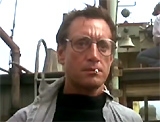 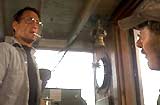
|

|
The Rocky Horror Picture Show (1975, UK/US)
An engaged young couple Brad (Barry Bostwick) and Janet (Susan Sarandon) mistakenly ended up in a large gothic castle after getting a flat tire in the middle of a rainy night while returning from a friend's wedding in Denton, TX. There, after a group of conventioneers from the planet Transsexual finished a rendition of the Time Warp, a black-cloaked figure descended in an elevator behind them, tapping one sequin-encrusted high-heeled boot. When the elevator opened behind the couple, the figure in the elevator turned, causing Janet to scream and faint at the sight of the heavily-made up character. As a greeting, mad transexual transvestite Dr. Frank N. Furter (Tim Curry) sang: "How ya do-a" to Brad. Then, he strutted boldly forward through a gauntlet lineup of the revelers to a stage. On a stage in front of a banner reading ANNUAL TRANSYLVANIAN CONVENTION, he dropped his black cloak to reveal his sexy, skimpy, cross-dressed outfit: a pearl necklace, a leather draw-string vest, a tight corset (with leather bikini briefs), fishnet stockings, black garters, and high-heeled boots. He then seductively sang the campy classic:
He invited the young couple to his lab for the unveiling of his creation - the perfect humanoid man named Rocky Horror. |
  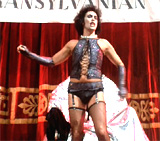 
|
(chronological, by film title) Introduction | 1920s-1935 | 1936-1939 | 1940-1945 | 1946-1949 | 1950-1955 | 1956-1959 | 1960-1965 | 1966-1969 1970-1975 | 1976-1979 | 1980-1985 | 1986-1989 | 1990-1995 | 1996-1999 | 2000-2005 | 2006-Present |